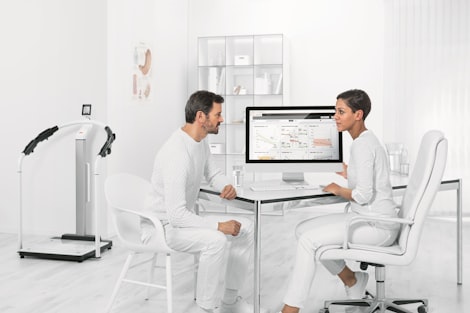Virtual desktop infrastructure (VDI) is a technology that allows healthcare organizations to provide secure and remote access to patient data and applications. VDI can help healthcare providers improve patient care and streamline workflows. However, implementing VDI in a healthcare setting can be complex, and there are certain best practices that organizations should follow to ensure success.
Let's discuss some of the best practices for implementing VDI in healthcare settings.
1. Assess Your Needs
Before implementing VDI, it's important to assess your organization's needs. Determine which applications and data are critical for patient care, and which users need access to them.
By assessing your organization's needs, you'll be able to determine the number of virtual desktops and the infrastructure requirements needed to support your organization.
2. Select the Right Solution
When it comes to selecting a VDI solution for your healthcare setting, it's crucial to carefully evaluate the available options. The market offers a range of VDI solutions, each with its own set of strengths and weaknesses. By considering key factors such as security, scalability, and ease of management, you can make an informed decision that best aligns with your organization's needs and budget.
Security is of paramount importance in healthcare, as patient data must be protected at all costs. When evaluating VDI solutions, prioritize those that offer robust security measures, such as end-to-end encryption, multi-factor authentication, and data loss prevention mechanisms. Look for solutions that comply with industry standards, such as HIPAA, to ensure the highest level of data protection.
Scalability is another crucial consideration. As your healthcare organization grows and evolves, your VDI solution should be able to accommodate increasing demands. Look for solutions that offer flexible scaling options, allowing you to add or remove virtual desktops as needed. Additionally, consider the ability to scale the infrastructure, including storage and computing resources, to support the growing demands of your organization.
3. Plan Your Infrastructure
Implementing a successful VDI environment necessitates careful planning and provisioning of a robust infrastructure to support the virtual desktops and applications. This infrastructure comprises essential components such as storage, compute, and networking resources, which are vital for ensuring optimal performance, scalability, and high availability of the VDI environment.
Storage plays a critical role in a VDI infrastructure, as it houses the virtual desktop images, user data, and applications. It's crucial to assess the storage requirements based on factors such as the number of virtual desktops, the size of the desktop images, and the types of applications being used. By accurately estimating storage needs, you can select the appropriate storage solution that provides sufficient capacity, performance, and data redundancy to support your VDI environment. Consider utilizing technologies like solid-state drives (SSDs) for faster read/write operations and data deduplication techniques to optimize storage efficiency.
Compute resources are essential for processing the workload generated by virtual desktops and applications. Assess the computing requirements based on factors such as the number of concurrent users, the complexity of applications, and resource-intensive tasks. Consider factors like CPU power, memory capacity, and GPU requirements for graphics-intensive applications. By accurately sizing and provisioning compute resources, you can ensure that the virtual desktops perform optimally and meet end-user expectations in terms of responsiveness and speed.
Networking is a crucial component that facilitates communication between virtual desktops, application servers, and end-user devices. Adequate network bandwidth and low latency are essential for delivering a seamless user experience. Assess the network requirements based on factors such as the number of users, data transfer volumes, and the types of applications being used. Implementing technologies like Quality of Service (QoS) can prioritize network traffic, ensuring smooth performance for critical applications. It's also important to consider network redundancy and load-balancing mechanisms to enhance availability and fault tolerance.
4. Consider Compliance Requirements
Healthcare organizations operate within a highly regulated environment, and compliance with industry standards is crucial to safeguard patient data and maintain confidentiality. Implementing a Virtual Desktop Infrastructure (VDI) solution in a healthcare setting requires careful consideration of compliance requirements, particularly those outlined in the Health Insurance Portability and Accountability Act (HIPAA). By selecting a VDI solution that incorporates robust security and compliance features, healthcare organizations can ensure the protection of sensitive information and meet the necessary regulatory standards.
When evaluating VDI solutions, prioritize those that offer strong security measures designed to protect patient data. Encryption is a fundamental security feature that ensures data confidentiality. Look for VDI solutions that provide end-to-end encryption for data in transit and at rest. This encryption ensures that sensitive patient information remains protected, even in the event of unauthorized access or data breaches.
5. Involve End-Users
End-users play a pivotal role in the successful adoption and utilization of a Virtual Desktop Infrastructure (VDI) solution within a healthcare organization. As they will be using the VDI solution on a daily basis, their involvement in the planning and implementation process is crucial to ensure that the solution aligns with their needs and workflows. By engaging end-users from the outset and providing adequate training and support, healthcare organizations can facilitate a seamless transition to the VDI environment and empower their staff to maximize the benefits of the solution.
Involving end-users during the planning and implementation phases allows healthcare organizations to gain valuable insights into their specific requirements and preferences. Conducting user surveys, focus groups, or individual interviews can provide a deeper understanding of their workflows, software application needs, and performance expectations. By incorporating their input, healthcare organizations can tailor the VDI solution to meet the unique needs of different user groups and enhance user satisfaction.
6. Test and Monitor
Once your Virtual Desktop Infrastructure (VDI) solution is implemented, ongoing testing and monitoring are critical to ensure optimal performance and meet the evolving needs of your healthcare organization. Regular testing allows you to proactively identify and resolve any issues before they impact patient care or disrupt daily operations.
Conducting regular testing of your VDI solution helps validate its functionality, performance, and compatibility with different applications and user scenarios. It enables you to assess the responsiveness and reliability of virtual desktops, application delivery, and data access. By simulating real-world scenarios and load conditions, you can evaluate the system's capacity to handle peak usage periods and ensure a seamless user experience. Testing also provides an opportunity to verify the effectiveness of disaster recovery and business continuity mechanisms in place.
How Anteris Can Help
In conclusion, when it comes to implementing a Virtual Desktop Infrastructure (VDI) solution in a healthcare setting, Anteris is here to provide invaluable assistance. With their expertise and guidance, organizations can navigate the complexities of VDI and ensure a successful implementation that significantly benefits patient care and enhances productivity.
Anteris starts by thoroughly assessing your organization's unique needs and requirements. They work closely with you to understand your specific challenges and goals, enabling them to recommend the right VDI solution that aligns perfectly with your healthcare environment.
Compliance is of utmost importance in the healthcare industry, and Anteris understands the complex regulatory landscape. They help you navigate through compliance requirements, ensuring that your VDI solution meets all necessary standards and safeguards patient data.
Testing and monitoring are ongoing processes that Anteris prioritizes. They conduct regular testing to identify any performance bottlenecks or potential issues, proactively addressing them before they impact patient care or productivity.
With Anteris by your side, implementing VDI in your healthcare setting becomes a streamlined and efficient process. They provide comprehensive support, tailored to your organization's needs, every step of the way. Trust Anteris to deliver a VDI solution that optimizes patient care, enhances productivity and sets your healthcare organization on a path to success.



